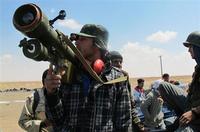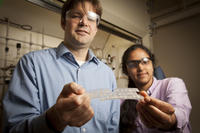-
Iran to send a first contingent of 4,000 Iranian Revolutionary Guards to Syria

In preparation for the attack by Assad forces on rebel-held Aleppo, Iran announced it is sending a first contingent of 4,000 Iranian Revolutionary Guards to Syria to help the Syrian military. Iran’s goal is to help Assad capture Aleppo, and inflict a decisive defeat on the rebels, before U.S., and European, military aid begin to make a difference on the battlefield. Iran has also announced that it and Hezbollah are planning to open up a new “Syrian” front on the Golan Heights against Israel, and the presence of 4,000 Revolutionary Guards in Syria will allow Iran to do so. The United States responded by saying that 3,000 U.S. troops, a detachment of F-16s fighter jets, and batteries of Patriot missiles will remain in Jordan after the joint U.S.-Jordan military exercise they are currently participating in is over.
-
-
Improving close air support for faster, more precise airstrikes
Air-ground fire coordination — also known as Close Air Support or CAS — is a dangerous and difficult business. While its tools have become more sophisticated, CAS has not fundamentally changed since the First World War. Now, Persistent Close Air Support (PCAS) program aims to improve air-to-ground fire coordination, but could revolutionize military technology development and deployment as well.
-
-
U.S. confirms: Assad used chemical weapons against Syrian rebels, civilians (updated)

The Obama administration has informed Congress a few minutes ago that the U.S. intelligence community has determined that the Assad regime has used chemical weapons on several occasions against both rebel forces and Syrian civilians. The U.S. intelligence community says these attacks, each using small quantities of sarin gas, have killed about 150 Syrians. The president’s deputy national security adviser, Ben Rhodes, told reporters that the president had decided to provide “direct military support” to the opposition. Rhodes said the U.S. military assistance to the rebels would be different in “both scope and scale” from what had been authorized before, which included non-lethal equipment such as night-vision goggles and body armor.
-
-
U.S. confirms: Assad used chemical weapons against Syrian rebels, civilians
The Obama administration has informed Congress a few minutes ago that the U.S. intelligence community has determined that the Assad regime has used chemical weapons on several occasions against both rebel forces and Syrian civilians. The U.S. intelligence community says these attacks, each using small quantities of sarin gas, have killed about 150 Syrians.
-
-
Al Qaeda-affiliated militants training in using shoulder-fired anti-aircraft missile

A Xerox copy of a 26-page manual with instructions on how to use man-portable air-defense systems, or MANPADS – also called SA-7 — was found in a building in Timbuktu in North Mali which was used by Al Qaeda in the Islamic Maghreb operatives during the 8-month control – April 2012 to February 2013 — of the area by Islamist militants. The Libyan military under Col. Qaddafi had about 15,000 SA-7s, but after the Qaddafi regime fell in November 2011, NATO forces and Libyan militias loyal to the government gained possession of only 5,000 of them. The rest have disappeared into the arsenals of different militias, and have probably found their way to different terrorist organizations in North Africa and the Middle East.
-
-
Making jet fuel from switchgrass

The Energy Department’s National Renewable Energy Laboratory (NREL) is partnering with Cobalt Technologies, U.S. Navy, and Show Me Energy Cooperative to demonstrate that jet fuel can be made economically and in large quantities from a renewable biomass feedstock such as switch grass. The project could spur jobs in rural America, lead to less reliance of foreign oil.
-
-
White House to conduct urgent, comprehensive review of U.S. Syria policy
The White House today and tomorrow is conducting an urgent, and comprehensive, review of U.S. Syria policy, with a major policy announcement expected Wednesday or Thursday. The urgency is the result of changes on the battlefield. Bolstered with thousands of Hezbollah fighters, growing financial support from Iran and Iraq, around-the-clock arms shipments from Iran and Syria, and more direct Iranian involvement in overseeing the regime’s military operations, the Assad government has been able to turn the tide of war in its favor. Senior administration officials believe that arming the rebels may no longer be sufficient to reverse the Assad government’s gains unless the United States takes additional, and more direct, steps like carrying out airstrikes against Syrian forces.
-
-
Studying rare Earth elements in Alaska may help make them less rare
A unique deposit of heavy rare Earth elements (REE) at Alaska’s Bokan Mountain could help scientists understand how rare Earth element deposits form, according to new research. Rare Earth elements are important, but scarce, elements used in components in many cutting edge electronic and defense technologies.
-
-
Better weather predictions for the U.S. Navy
In a development that should significantly affect fleet operations, the U.S. Navy has adopted a new global weather forecasting model. The Naval Global Environmental Model (NAVGEM)could inform Navy operations for years to come. It is particularly important as U.S. fleet presence increases throughout the Asia-Pacific region, known for intense weather events like typhoons.
-
-
The two-track Syria strategy of Iran and Hezbollah
For Iran and Hezbollah, the preservation of Bashar Assad regime is of supreme strategic importance, but both realize the regime may not survive. Iran and Hezbollah, therefore, employ two parallel strategic tracks. The first, immediate track aims to prop up the Assad regime’s ability to survive and continue governing by providing it with military, economic, political, and propaganda support. The second track, planned as an intermediate- and long-term strategy, aims to make it possible for Syria’s Shi’ites and Alawites to defend themselves by creating a “popular army.” To help the first track, Hezbollah has sent thousands of its best fighters to fight on the side of the Assad regime and help the regime keep its hold over areas in northwest Syria. To advance the second track, Hezbollah, with Iranian funding, is helping the Assad regime build and train a popular army of about 150,000 Alawite and Shi’a soldiers. This army will protect the interests of the Alawite and Shi’a communities – and the interests of Iran and Hezbollah — in Syria if the Assad regime falls.
-
-
Highly sensitive polymer detects IEDs

A chemical which is often the key ingredient in improvised explosive devices (IEDs) can be quickly and safely detected in trace amounts by a new polymer created by a team of Cornell University chemists. The polymer, which potentially could be used in low-cost, handheld explosive detectors and could supplement or replace bomb-sniffing dogs.
-
-
France weighing military options after French lab confirms Syrian use of sarin gas
Laurent Fabius, France’s foreign minister, said yesterday (Tuesday) that samples taken from Syria and tested in France confirm that sarin gas has been used by the Assad regime in several attacks in March and April. The U.K. Foreign Office said that samples from Syrian victims tested in British labs also confirmed the use of sarin. A UN investigative panel released its report yesterday, saying its experts had “reasonable grounds” to suspect small-scale use of toxic chemicals. Fabius said that France was not ruling out a military strike on the place where the gas is being stored.
-
-
McCain: military aid to rebels, no-fly zone necessary as Assad gaining “upper hand”

Senator John McCain (R-Arizona) said it is “ludicrous” to believe that Syrian president Bashar al-Assad would negotiate a diplomatic solution to the county’s civil war at an upcoming summit. McCain says that providing military aid to the anti-Assad rebels and imposing a no-fly zone over Syria would more likely yield results than a summit meeting in Geneva.
-
-
Hagel says Chinese cyberattacks a “growing threat”
Defense Secretary Chuck Hagel warned of a “growing threat” of cyberattacks against the United States, saying that America and its allies need to “establish international norms of responsible behavior in cyberspace.” Hagel spoke to an audience of defense analysts and defense ministers from Asia and Europe at the annual conference of the International Institute for Strategic Studies on Saturday.
-
-
Israel warns: if S-300 missiles arrive in Syria, Israel will “prevent” them from becoming operational
Israeli prime minister Benjamin Netanyahu said that if Russia went ahead with its planned sale of advanced S-300 air defense missiles to Syria, and these systems became operational, then Israel’s “entire airspace will become a no-fly zone.” Netanyahu warned that the threat was such that Israel “cannot stand idly by.”
-
More headlines
The long view
Factories First: Winning the Drone War Before It Starts
Wars are won by factories before they are won on the battlefield,Martin C. Feldmann writes, noting that the United States lacks the manufacturing depth for the coming drone age. Rectifying this situation “will take far more than procurement tweaks,” Feldmann writes. “It demands a national-level, wartime-scale industrial mobilization.”
